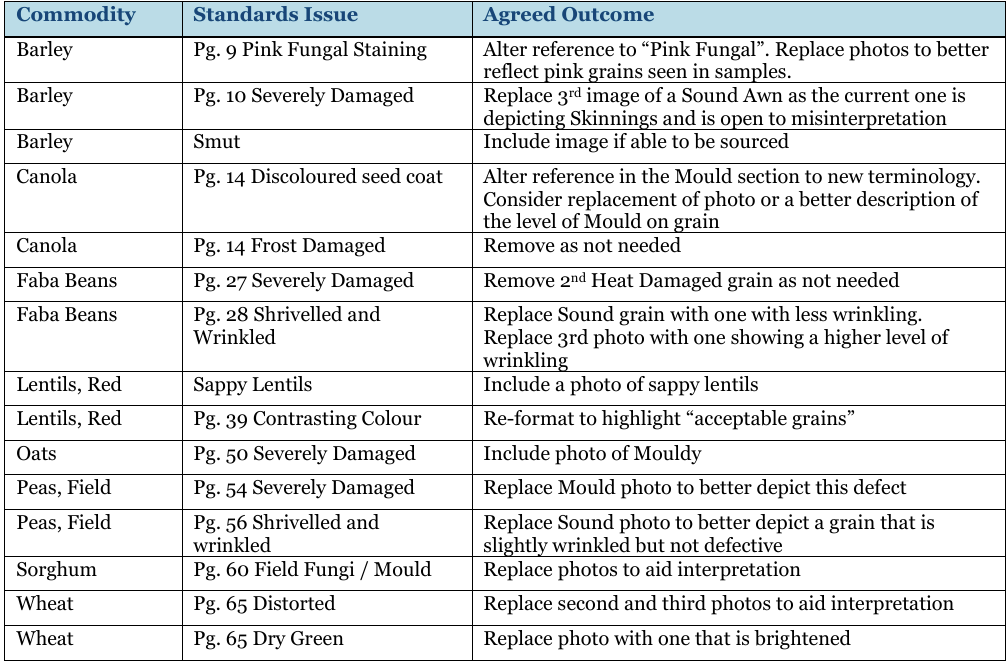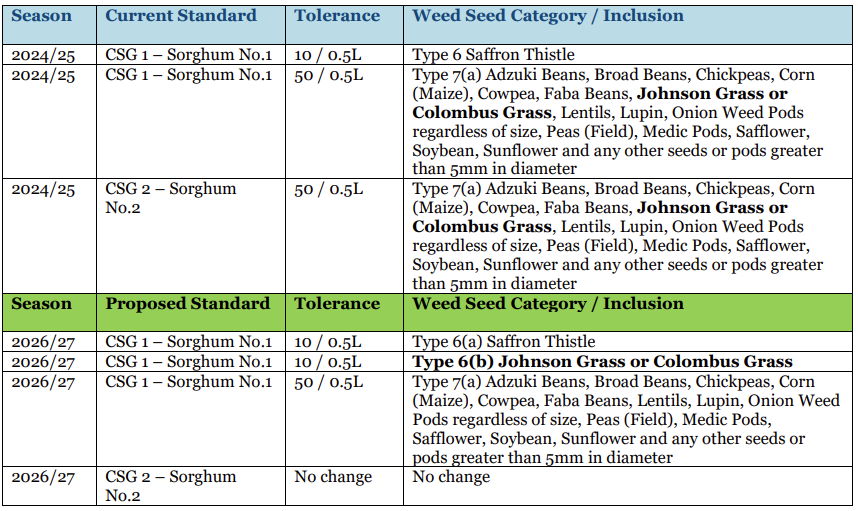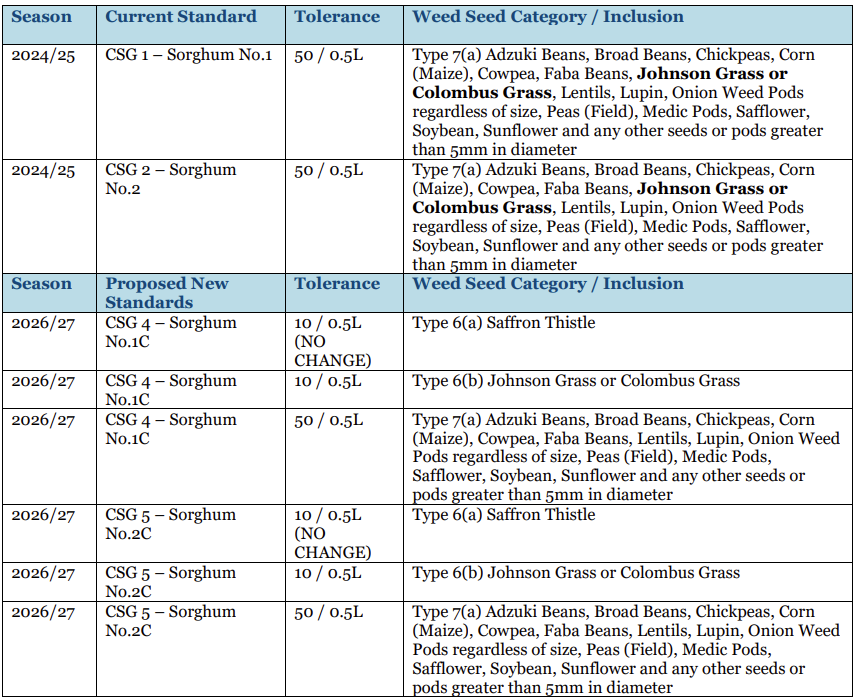
DISTRIBUTION: GTA Members – primary contact list. Please circulate to all appropriate internal parties.
1. Issue
During deliberations on the development of Grain Trading Standards (Standards) for the 2024/25 season, industry feedback was received by GTA on the proposed changes for 2024/25 and potential changes for the following 2025/26 season.
The GTA Trading Standards Committee (Committee) has recently met to discuss industry feedback received and the potential Standards for 2025/26.
This document is provided for industry consideration and feedback.
2. Process for Industry Feedback
The Committee is seeking industry comment on the issues outlined in this document and on any other Standards related issue.
Submissions should be received by COB Friday, 14 March 2025.
Please lodge your submissions by sending to submissions@graintrade.org.au and title your email – Standards Review 2025/26.
Industry is encouraged to provide supporting evidence for any change proposed in Standards. Preference is for industry to use the proforma for lodging submissions located on the GTA website.
Unless marked “confidential” and appropriate supporting reasons are provided, all submissions will be placed on the GTA website for industry review.
3. Agreed Changes for Adoption in 2025/26
3.1 Agreed Change: Visual Recognition Standards Guide – All Commodities
A revised version of the VRSG was published for the 2024/25 season. At present, the Committee has decided that whilst further major changes are not required, there are several minor amendments that may add value. As such, the Committee will re-publish a revised version for 2025/26 with the following changes proposed.


3.2 Agreed Change: Minor Wording Changes & Other Issues – Cereal & Pulse Commodities
Minor changes to wording in all relevant Standards charts and Standards booklets will occur. These changes will refer to the latest versions of reference material available to assist industry implementation of Standards, including:
3.3 Agreed Change: Varietal Master List – Wheat, Barley, Oats
As in previous seasons, the Varietal Master List for the above commodities will be reviewed following receipt of the changes from the industry sector responsible for maintenance of those lists. All Standards will be revised based on those changes and advised to industry when the 2025/26 season Standards are released. In the interim, refer to the Trading Standards Booklets for each commodity to view the existing varietal classifications.
Note that GTA will place the list of varieties for all commodities (except mung beans) on the GTA website for industry reference.
3.4 Agreed Change: Procedures – All pulse commodities except Mung Beans
Industry was advised during 2024 that as GTA now develops the Pulse Trading Standards (except mung beans) on behalf of industry, the Committee had commenced revising the Pulse Standards Booklet with the intention of making the Booklet appear as per cereals. While some procedures were revised for the 2024/25 Standards Booklet, several remain to be done, and the Committee intends to develop the remaining procedures during 2025 where technically feasible and timeframes allow.
3.5 Agreed Change: Screen Size – Fenugreek
The Fenugreek Standards reference a screen and include “all Fenugreek seed material falling through the screen” in the Total Defective category. However, despite previous attempts for information, an appropriate screen size could not be obtained for reference in the Standard to assist industry interpretation.
The Committee has received advice that a 1.4mm slotted screen is appropriate, hence it is proposed to reference this screen in the 2025/26 Fenugreek Standards in the following areas:
4. Issues for Further Ongoing Consideration
4.1 Further Research: Vacuum Sampling of Road Trucks – All Commodities
The project to review the appropriateness of sampling systems on receival from road trucks has completed its initial phase. Based on initial findings, further research was highlighted as needed and is now being undertaken by the Grains Research and Development Corporation (GRDC).
Industry will be advised of findings in due course.
4.2 Further Review: SFW1 – Wheat
Industry was advised in 2020 of a submission requesting a change in the tolerances for a range of defective grain types in the SFW1 grade. That submission in total was not supported and no changes to the tolerances occurred. Since that time, a further submission requesting changes to Field Fungi and Severely Damaged grains only was received.
The submission requested changes as follows:
Discussion by the Committee on this topic included:
The Committee continues consultation on the proposed changes with the stockfeed sector. Industry will be advised of the findings during 2025.
4.3 Further Review: Sorghum – Johnson Grass / Columbus Grass Tolerance
A submission was received from industry seeking a change in the current tolerance in the No.1 grade sorghum Trading Standard for Johnson Grass / Colombus Grass. The submission highlighted that the current tolerance of 50 seeds / 0.5L significantly exceeds the tolerance required by a major market for Australian sorghum and advised that this difference makes sourcing grain and supplying the market difficult.
To assist compliance with the importing country requirement for Johnson Grass / Columbus Grass, the submission sought the reduction in tolerance of 50 seeds / 0.5L to 10 seeds / 0.5L for the No.1 grade for these two seeds only. The tolerance and weed seed inclusions in the existing Type 7(a) category in the current No.1 grade would remain.
The Committee discussed the submission and a number of other options to meet market requirements:
Option 1:

Option 2:

Option 3:
4.4 Further Review: Broad Beans – Colour References
The current Broad Bean Standards have various references to colour, including evergreens, old seasons, dark beans, black beans and beans that are “distinctly off colour from the characteristic colour of the predominating class”.
While the Pulse Sub-Committee has considered this issue previously with a view to provide guidance on interpretation by industry, no changes were made to the Standards. Industry will also note that no photos exist in the VRSG for Broad Beans, as the current Faba Bean photos are to be used.
The Committee intends to review all colour related issues in the Broad Bean Standards and the need for further guidance to industry, which may include provision of photos for all colour parameters for Broad Beans in the VRSG. The Committee intends to contact the industry stakeholders directly involved in the Broad Bean supply chain however the Committee welcomes comments from any industry stakeholder on this matter. The findings of the Committee will be provided to industry during the second round of industry consultations proposed for May 2025.
4.5 Further Review: Kabuli Chickpeas – Sizing
The current Kabuli Chickpea Standards refers to small as 5-6mm in diameter and large as greater than 6mm in diameter. The Committee has been advised that there may be a difference in the view of breeders/classification of Kabuli Chickpeas, with any Kabuli less than 8mm considered small.
The Committee will discuss this issue with the relevant industry stakeholders and advise findings to industry, including any potential change to Standards, during the second round of industry consultations proposed for May 2025.
Member Update No. 23 of 2025 – GTA Board Appointments 2025-2026
29 October 2025
Member Update No. 19 of 2025 – GTA Annual General Meeting 2025 Notice
26 September 2025
Stay updated on industry news and events. Subscribe now for exclusive updates and insights!
Self Regulatory Framework
NEWS
Self Regulatory Framework
NWPGP
NEWS
Events
Street Address
Level 7
12 O'Connell Street
Sydney NSW 2000
Postal Address
PO Box R1829
Royal Exchange
Sydney NSW 1225
Street Address
Level 7
12 O'Connell Street
Sydney NSW 2000
Postal Address
PO Box R1829
Royal Exchange
Sydney NSW 1225